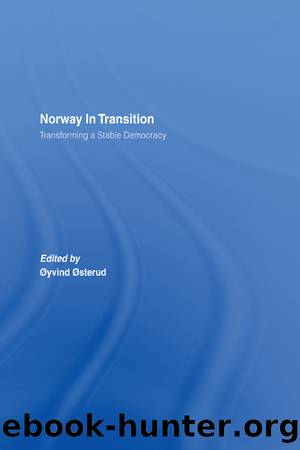Norway in Transition: Transforming a Stable Democracy by Oyvind Osterud

Author:Oyvind Osterud [Osterud, Oyvind]
Language: eng
Format: epub
Tags: Political Science, General
ISBN: 9781317970361
Google: jdGMAQAAQBAJ
Barnesnoble:
Goodreads: 20859214
Publisher: Routledge
Published: 2006-01-01T00:00:00+00:00
The End of Cleavage Politics?
In the 1980s the conservative and centre-right governments (1981â86) worked to liberalise the economy and to reform the âsocial-democratic stateâ built by the Labour Party after World War II. Two highly visible policies of the new Conservative government was the extended opening hours for shops and the end of the broadcasting monopoly. These changes challenged the old left to reconsider their traditional âstatistâ reflexes, and opened a debate on which of Labour's legacies were worth keeping (Førde 1989). Did the âopen society, new stateâ policies of the bourgeois governments and the response of Labour also signal the end of cleavage politics?
Looking at Norwegian voters, the answer is ânoâ; cleavages still help explain electoral choices, even if researchers might differ on the relative weight of âoldâ versus ânewâ cleavages and the importance of value orientations for electoral behaviour (Aardal 2003; Knutsen 2004). How is this stability reflected in the partiesâ programmes and policies since the 1980s? Have the changing surroundings and new membership influenced partiesâ political profiles? Traditionally, Norwegian politics has been consensual and multi-dimensional compared to other European countries, Britain for example. There are many ârelevant partiesâ which are fighting many cleavage dimensions simultaneously, but with little tendency towards polarisation.
The familiar political landscape painted by Rokkan and Valen since the early 1960s â with its leftâright dominance and with the centreâperiphery conflict and the moralâreligious issues added â was still very much in evidence among delegates to party conferences in the mid-1980s (Heidar 1988). However, they needed to be supplemented by divisions over environmental policies. The question is now: Have later developments â the media politics, the electoral volatility or the Europeanisation and globalisation processes â cut the parties loose from old cleavage politics?
Download
This site does not store any files on its server. We only index and link to content provided by other sites. Please contact the content providers to delete copyright contents if any and email us, we'll remove relevant links or contents immediately.
What's Done in Darkness by Kayla Perrin(25499)
Shot Through the Heart: DI Grace Fisher 2 by Isabelle Grey(18218)
Shot Through the Heart by Mercy Celeste(18159)
The Fifty Shades Trilogy & Grey by E L James(17773)
The 3rd Cycle of the Betrayed Series Collection: Extremely Controversial Historical Thrillers (Betrayed Series Boxed set) by McCray Carolyn(13188)
The Subtle Art of Not Giving a F*ck by Mark Manson(12903)
Scorched Earth by Nick Kyme(11831)
Stepbrother Stories 2 - 21 Taboo Story Collection (Brother Sister Stepbrother Stepsister Taboo Pseudo Incest Family Virgin Creampie Pregnant Forced Pregnancy Breeding) by Roxi Harding(11036)
Drei Generationen auf dem Jakobsweg by Stein Pia(10216)
Suna by Ziefle Pia(10185)
Scythe by Neal Shusterman(9258)
International Relations from the Global South; Worlds of Difference; First Edition by Arlene B. Tickner & Karen Smith(8607)
Successful Proposal Strategies for Small Businesses: Using Knowledge Management ot Win Govenment, Private Sector, and International Contracts 3rd Edition by Robert Frey(8416)
This is Going to Hurt by Adam Kay(7693)
Dirty Filthy Fix: A Fixed Trilogy Novella by Laurelin Paige(6450)
He Loves Me...KNOT by RC Boldt(5804)
How to Make Love to a Negro Without Getting Tired by Dany LaFerrière(5376)
Interdimensional Brothel by F4U(5302)
Thankful For Her by Alexa Riley(5158)
